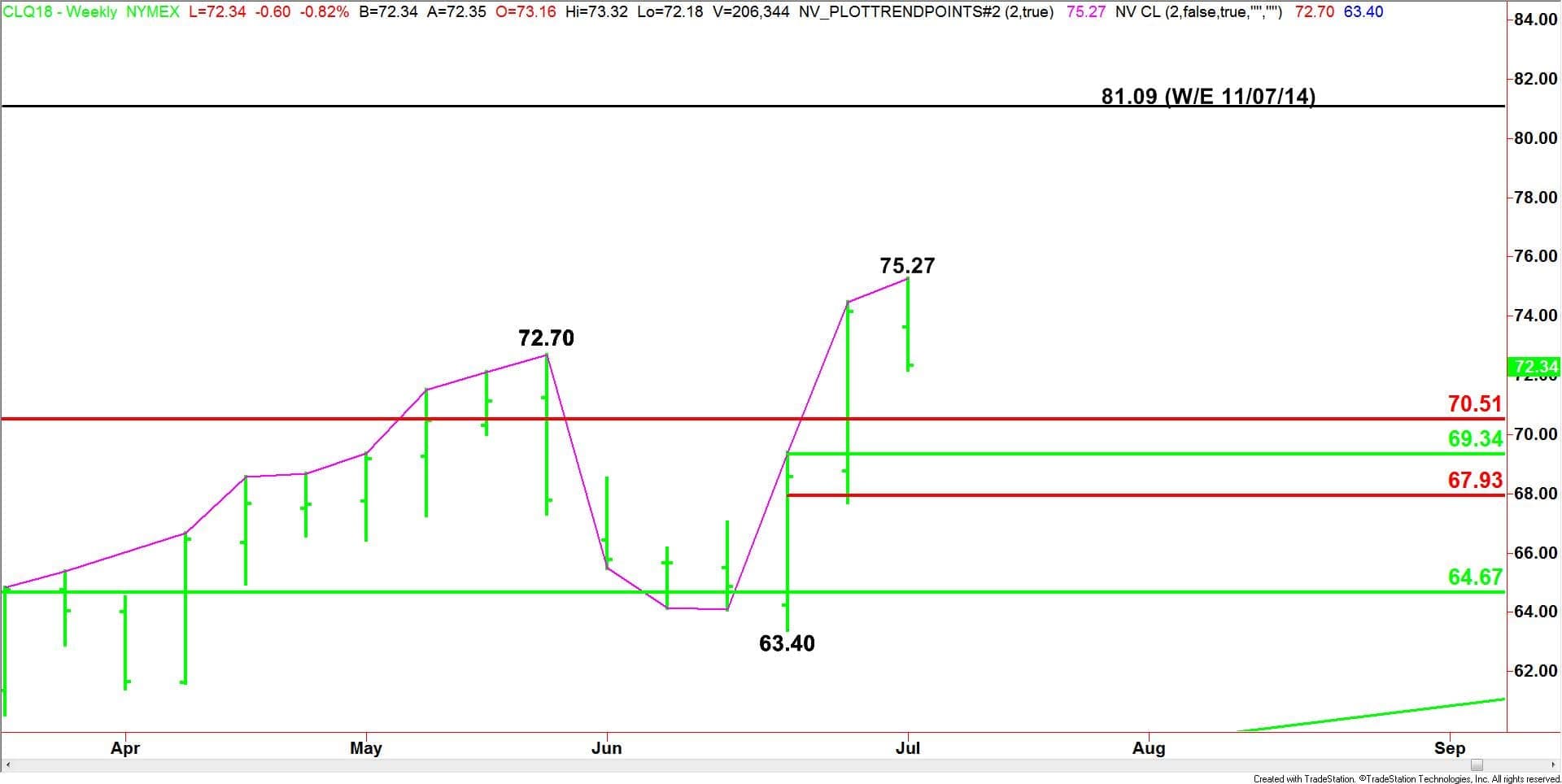U.S. West Texas Intermediate crude oil futures are in a position to post a technically bearish closing price reversal top on the weekly chart. While this chart pattern may not lead to a change in the trend, it doesn’t indicate that the selling is greater than the buying at current price levels.
Some of the selling pressure may have been fueled by the Tweet from President Trump over the weekend that said he had reached an agreement with the Saudis to increase production by as much as 2 million barrels per day, but we all know that the number was well off the amount the Saudis could conceivably deliver at this time. However, it did increase the focus on the tremendous supply issues the crude oil market is facing at this time. The news also brought attention to reports of increasing Saudi production.
Most of the talk this week has been about supply with a few smatterings of comments on demand.
This week’s price action indicates the market appears to have absorbed the recent announcement that an OPEC-led group and Russia will raise output by about 1 million bpd. Most of the rally has been fueled by supply disruptions in Canada, Venezuela and Libya as well as the looming sanctions against Iran.
Earlier in the week, Reuters reported that OPEC pumped 32.32 million bpd in June, up 320,000 bpd from May. The June total is the highest since January 2018.
King Salman said Saudi Arabia is ready to deploy the nation’s spare capacity to add more oil to the market.…
U.S. West Texas Intermediate crude oil futures are in a position to post a technically bearish closing price reversal top on the weekly chart. While this chart pattern may not lead to a change in the trend, it doesn’t indicate that the selling is greater than the buying at current price levels.
Some of the selling pressure may have been fueled by the Tweet from President Trump over the weekend that said he had reached an agreement with the Saudis to increase production by as much as 2 million barrels per day, but we all know that the number was well off the amount the Saudis could conceivably deliver at this time. However, it did increase the focus on the tremendous supply issues the crude oil market is facing at this time. The news also brought attention to reports of increasing Saudi production.
Most of the talk this week has been about supply with a few smatterings of comments on demand.
This week’s price action indicates the market appears to have absorbed the recent announcement that an OPEC-led group and Russia will raise output by about 1 million bpd. Most of the rally has been fueled by supply disruptions in Canada, Venezuela and Libya as well as the looming sanctions against Iran.
Earlier in the week, Reuters reported that OPEC pumped 32.32 million bpd in June, up 320,000 bpd from May. The June total is the highest since January 2018.
King Salman said Saudi Arabia is ready to deploy the nation’s spare capacity to add more oil to the market. And the UAE’s Abu Dhabi National Oil Co. (ADNOC) said on Tuesday it could increase production by several hundred thousand barrels per day if needed.
The size of the OPEC production increase and the verbal commitments from Saudi Arabia and the UAE is further evidence that hitting a 2M bpd increase will be a challenge. It may be a longer-term factor, but short-term, crude oil bulls are more interested in the supply disruptions.
The debate at this time is how to compensate for disruptions in Libya, Venezuela and Iran. Some argue that Saudi Arabia, Russia and the UAE, along with surging U.S. exports will cover the shortage. Others believe, the market may be undersupplied by 600,000 bpd over the next six months.
Some are saying that the United States’ recent declaration of zero tolerance for Iranian exports has caused bullish investors to reassess the impact of U.S. sanctions on Iran’s exports, believing that shipments may fall by 1.1 million bpd by year end. Previously, the market had priced in a loss of about 700,000 bpd through 2019.
How much oil is supplied or taken off the market will determine whether WTI crude oil surges to $80 per barrel, or plunges to $62 - $63 per barrel.
The Fundamentals
On Thursday, the U.S. Energy Administration (EIA) announced that U.S. crude inventories had risen 1.2 million barrels in the week to June 29, to 417.88 million barrels. This news was generally thought of as bearish because traders had been pricing-in a 4.4 million barrel decline.
Additionally, gasoline stockpiles fell by 1.5 million barrels for the week, but distillate stockpiles were up by 100,000 barrels for the week, according to the EIA. Traders were looking for a decrease of 2.5 million barrels for gasoline, and 250,000 barrels for distillate stocks.
China May Be the Wildcard in Supply/Demand Equation
Traders are paying attention to the escalating trade dispute between the United States and China although the current products caught in the tariff war are not energy-related. However, oil traders should continue to monitor the events because Beijing has threatened a 25 percent tariff on U.S. crude imports, although it has not specified an introduction date.
According to the latest estimates, American crude shipments to China are around 400,000 barrels per day (bpd), worth $1 billion a month at current prices.
An additional fact to consider: Tariffs would make U.S. oil uncompetitive in China. This means China would begin buying more oil from the Middle East or West Africa.
How close is China to imposing the tariff on U.S. crude oil? On Thursday, an executive from China’s Dongming Petrochemical Group said he expected Beijing to soon impose the tariff on U.S. oil imports. He added that his refinery had cancelled U.S. crude imports and would switch to Middle East or West African supplies instead.
Shortages to Worsen?
In other news, potential supply shortages continue to be the hot topic. Venezuela is expected to lose another 400,000 bpd by year-end with production going to below 1 million bpd. Additionally, about 300,000 bpd of Libyan oil has been taken off the market.
The major story remains the looming supply shortages due to U.S. sanctions against Iran. By some estimates, about 1.7 to 2 million bpd of crude and condensate would be cut out of markets once the sanctions are implemented.
Saudi Arabia and Russia have agreed to increase output, but most of their 1 million bpd increase was expected to cover the short fall from Iran. At this time, there may not be enough spare capacity to cover the losses from Venezuela and Libya.
August West Texas Intermediate Crude Oil Technical Analysis

(Click to enlarge)
The thing about a trending market that is reaching multi-year highs is that it doesn’t take a lot of indicators to analyze it. We basically have the trend indicator and support and resistance.
Weekly Technical Analysis
The main trend is up according to the weekly swing chart. This was confirmed the prior week when buyers took out $72.70. The trend will change to down when sellers take out the last bottom at $63.40. If the rally continues through $75.27 then the next upside target will be the November 7, 2014 main top at $81.09.
The swing chart is pretty clear and the best trend indicator we have available.
Momentum is another thing, however. We are currently in an uptrend, but in a position to shift trading momentum to the downside. All we need is a close below $74.15 on Friday to accomplish this.
Since $72.70 was the breakout point to the upside, crossing back below it will be another sign that the selling pressure is increasing. In other words, those traders who bought strength during the week-ending June 29 are going to have to sell out of their losing positions. This should drive momentum to the downside.
The short-term range is $63.40 to $75.27. If the selling pressure continues then look for a correction into its 50% to 61.8% retracement zone at $69.34 to $67.93.
The retracement zone at $69.34 to $67.93 is the primary downside target. It is also a value zone. Since the main trend is up, we expect new buyers to show up on a test of the value zone.
Additionally, since the fundamentals are still bullish, buyers are going to have more confidence in continuing to play the long side of the market. Having been burned already buying strength. They are going to come back into the market but only when they can get a good price.















